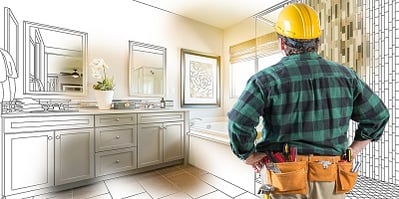
Bathroom remodeling can either be quick and easy or complicated and expensive. Which is the case depending on how large the bathroom is, how old it is and of course, how extensive your client wants the renovation to be. Here we're focusing on renovation jobs more complex than simply replacing the sink or toilet, and we're going to cover several key installation and remodeling tips for avoiding easy-to-make mistakes.
We'll also cover the importance of a secure bathroom subfloor, and how fastening it down correctly with the right tools, such as BECK’s SCRAIL® SUBLOC® PRO fasteners, can be extremely helpful for long-lasting durability. Now, let's get down to the essential do's and don'ts.
- Don't Start Working Without a Plan
Bathrooms are delicate installations with quite a bit more complexity than your average household room. Because of this, just walking in and tearing old finishing work right out can cause problems if you're not ready to continue the process right to completion in one single timeframe.
Before you start pulling out the toilets, sink, bathtub, and other parts, make sure that you and your client have a clear budget and layout plan. This should include what to remove, what to keep and what kind of layout and materials the new installation will have. Also make sure that you have a clearly verified budget for the entire project. Doing these things will ensure you avoid major mistakes.
- Keep Layout and Spacing in Mind
Bathrooms tend to be smaller spaces than most other rooms in the house (with some notable exceptions). Because of this, their layout and spacing often have limitations that you should absolutely keep in mind. Before you've even torn out the old parts of the bathroom you're remodeling, make sure that the new parts you're planning on installing will be sized and laid out correctly. They should fit in such a way that the bathroom space continues to be comfortably functional for daily use by multiple people.
- Pick Your Materials Carefully
Along with kitchen spaces, bathrooms are probably the rooms in your house that will regularly undergo some of the worst stresses. The fixtures, walls, floors, and all finishing work will have to regularly withstand high humidity, steam, water spills and plenty of abrupt temperature changes. Consequently, the materials that should be used for all bathroom installations are those specifically designed for bathrooms and wet spaces.
For example, pick the drywall behind your shower or bathtub space carefully, pick the sealant caulk you use carefully and ensure that the cement, glue and grout mixes you use for any tile or fixture installation work are all designed to handle moist conditions for years on end. The wrong materials in a freshly installed bathroom can shorten its functional life by years.
- Change Placements with Caution
Remodeling the fixtures and key components of your bathroom can be costly, but it's possible to keep the price for customers down to an acceptable level by simply not relocating key facility elements. In other words, sure, go ahead and change out the tub, redo the tiling for something more modern and feel free to replace sink and toilet fixtures with new installations. But avoid moving any of these key elements completely. Changing the location of a toilet, sink, bathtub, or shower space can incur major new logistics and specialist plumbing installation expenses that might not be necessary.
- Don't let Small Mistakes Cost You
Little things can ruin a bathroom installation project just as easily as major mistakes, only they might do it more insidiously. If you've installed your toilet or sink the wrong way, you'll know it almost immediately after a client first uses the bathroom, but if you've used the wrong kind of tile glue—possibly one with weak water resistance—on bathroom tile installations, the damage this causes might take months to become visible. Avoid this by being very careful right from the start.
- Don't Forget the Subfloor
Subfloors are a crucial part of any major bathroom remodeling job. They let you ensure that your new tile floors are evenly installed, that the bathroom’s original underlayment is protected against remodeling work and that the finishing's can be installed smoothly. If you're doing any major remodeling work for a bathroom, making a new subfloor a part of the installation is a wise idea. A subfloor fastened down carefully with highly corrosion resistant, long-lasting fasteners such as BECK’s SCRAIL® SUBLOC® PRO can last for decades. It can also make tile installation and bathroom floor waterproofing much easier to professionally ensure. To learn more about how SCRAIL® SUBLOC® PRO fasteners can help with the subfloor part of your project, click below!
.svg.png)

